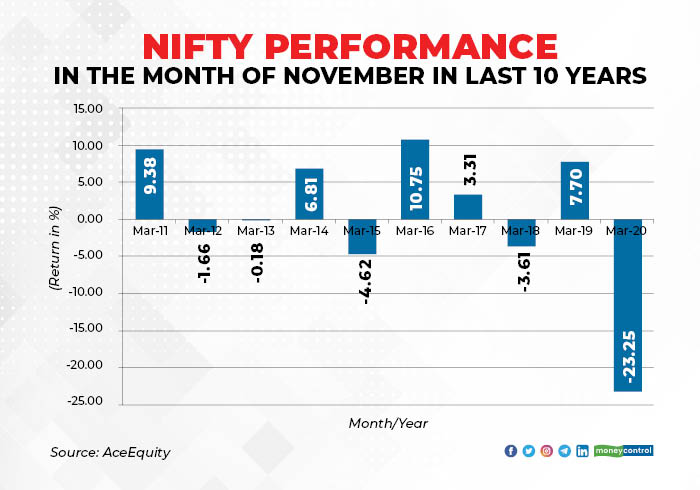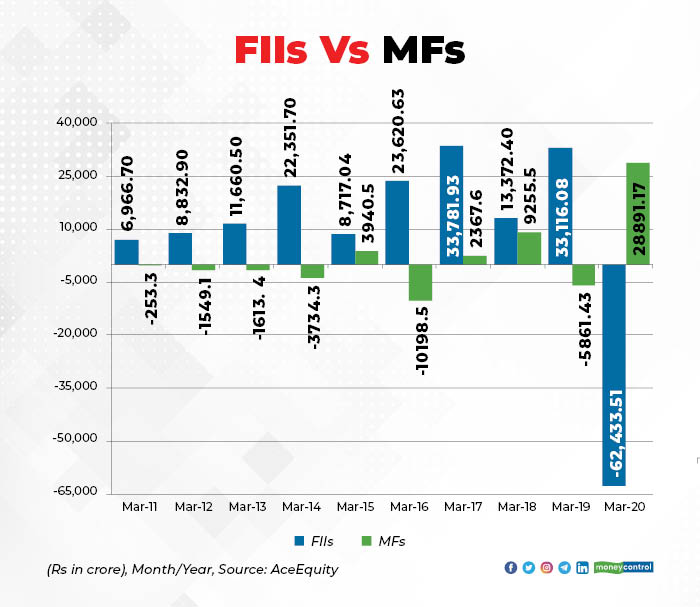After closing February with gains of more than 6 percent, which way will Indian markets head in March? Experts say that stocks are likely to maintain the uptrend in the current month too, although volatility is likely to increase, and rising US bond yields and crude oil prices play spoilsport.
Historically, bulls and bears have remained in equal control of D-Street in the last 10 years, data from AceEquity showed.
In five instances, the Nifty jumped over 10 percent in March 2016, followed by 9 percent in March 2011, and over 7 percent in March 2019 – three of the biggest gains in the month.
On the other hand, bears dominated the market in other five instances in March in the last 10 years. Three of those instances are 2020 (Nifty down over 23 percent, hit by the COVID pandemic worldwide), 2015 (Nifty down 4.6 percent), and 2018 (Nifty down 3.6 percent).

Dips are part of a healthy bull market, and long-term investors should use them to get into quality stocks. The Indian market is in a steady uptrend and as long as India Inc continues to deliver and micro and macro data remain strong, most dips will be bought into.
Since bottoming out in March last year, the Nifty has been in a steady uptrend, as it has consistently made a sequence of higher highs and higher lows.
“Within this bull market, there have been four major price corrections, lasting between 7 and 11 percent, and averaging 9.5 percent. The most recent correction, from the record high of 15,431, has seen the Nifty correcting a little over 6 percent,” Abhishek Chinchalkar, CMT at FYERS, told Moneycontrol.
“Going by the magnitude of the average corrections over the last 10 months and the structure of the candle set-up, a correction towards 14,300/13,800 cannot be ruled out until the index trades below the high of the Abandoned Baby Top candle, which is 15,176,” he said.
Chinchalkar further added that the overall uptrend remains intact, and, as such, corrections must be used as buying opportunities for the medium term.
What to watch out for?
A rise in US Treasury Yields is a near-term negative but it will not be easy for bears to take control of D-Street in March as strong auto sales numbers for February, steady GST collections as well as a robust performance of India Inc for the December quarter are likely to lend support.
“We can expect higher volatility in March as the February monthly expiry closing was weak, followed by some massive FII/ETF selling on Friday. Post the Union Budget and earnings season, there is no major domestic trigger that can drive our markets on its own. Hence, we could follow global cues,” Rusmik Oza, Executive Vice President, Head of Fundamental Research, Kotak Securities, told Moneycontrol.
“The key things to watch out for in the very near future is how the US goes through the fiscal stimulus and whether bond yields cross the 1.5-percent mark. For India, the crude price movement is very important as retail diesel and petrol prices have gone up sharply,” he said.
For Nifty, the 50-DMA at 14,428 is a crucial support level to watch out for, he said. In case it breaks the 50 DMA level, the Nifty-50 can slide below the 14,000 to about 13,600 levels. Broadly, 14,500-15,500 could be a range to watch out for in the very near future.
FIIs & DII activity
Foreign institutional investors (FIIs), which have pulled out more than Rs 60,000 crore from the Indian equity markets on a net basis in March 2020, were mostly net buyers, according to anecdotal data.
FIIs have been net buyers for nearly Rs 34,000 crore in March 2017. There were net inflows to the tune of Rs 33,000 crore in March 2019, and Rs 23,620 crore in March 2016.
DIIs were mostly net sellers in March in six out of the last 10 years. They had pulled out more than Rs 10,000 crore in 2016, Rs 5,861 crore in 2019, and Rs 3,734 crore in March 2014.

Experts are of the view that there could be some pressure on the debt market, if US Treasury Bond Yields continue to rise.
“FII flows will see a fall in the bond market as yields will rise. The increasing inflation numbers and probability of a hike in interest rate will increase,” Vishal Wagh, Research Head, Bonanza Portfolio Ltd, told Moneycontrol.
The US yields rose quite substantially last month, with the benchmark 10-Year Yield surging to around 1.6 percent, a level that was last seen a year ago. That said, yields have cooled off a bit since Friday, with the 10-Year yield softening over 15 basis points, having moved above the lows of 2012 and 2016.
“For now, one needs to focus on how the US yields move from here. If Friday’s reversal causes US yields to soften a bit over the next few days, risk aversion is likely to recede across the board,” says Chinchalkar of FYERS.
“That said, if nominal US yields continue to rise and real US yields inch closer towards becoming positive, we could see the second wave of selling in the global bond and equity markets,” he said.
Disclaimer: The views and investment tips expressed by experts on Moneycontrol.com are their own and not those of the website or its management. Moneycontrol.com advises users to check with certified experts before taking investment decisions.
